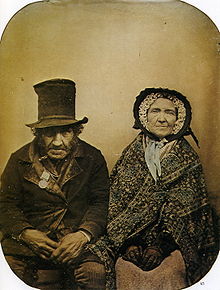- Collodion
-
Collodion is a flammable, syrupy solution of pyroxylin (a.k.a. "nitrocellulose", "cellulose nitrate", "flash paper", and "gun cotton") in ether and alcohol. There are two basic types; flexible and non-flexible. The flexible type is often used as a surgical dressing or to hold dressings in place. When painted on the skin, collodion dries to form a flexible cellulose film. While it is initially colorless, it discolors over time. Non-flexible collodion is often used in theatrical make-up.
Contents
Wet plate collodion photography
In 1851, the Englishman Frederick Scott Archer discovered that collodion could be used as an alternative to egg white (albumen) on glass plates. This also reduced the exposure time when making the image. This became known as the 'wet plate collodion' or 'wet collodion' method. Collodion was also grainless and colorless, and allowed for one of the first high quality duplication processes, also known as negatives. This process also produced positives, the ambrotype and the tintype (also known as 'ferrotype').
The process required great skill and included the following steps:
- Clean the glass plate (extremely well)
- In the light, pour "salted" (iodide/bromide) collodion onto the glass plate, tilting it so it reaches each corner. The excess is poured back into the bottle.
- Take the plate into a darkroom or orange tent (the plate is only sensitive to blue light) and immerse the plate in a silver nitrate sensitising bath (for 3–5 minutes)
- Lift the plate out of the bath, drain and wipe the back and load it into a dark slide (UK terminology) or plate holder (US terminology)
- Load the plate holder into the camera, withdraw the dark slide and expose the plate (can range from less than a second to several minutes)
- Develop the plate (using a ferrous sulfate based developer)
- Fix the plate (with potassium cyanide or sodium thiosulfate)
All of this was done in a matter of minutes, and some of the steps in (red) safelight conditions, which meant that the photographer had to carry the chemicals and a portable darkroom with him wherever he went. After these steps the plate needed rinsing in fresh water. Finally, the plate was dried and varnished using a varnish made from sandarac, alcohol and lavender oil.
Dark tents to be used outdoors consisted of a small tent that was tied around the photographer's waist. Otherwise a wheelbarrow or a horse and covered wagon were used.
Dry collodion plates
Richard Norris, a doctor of medicine and professor of physiology at Queen's College, Birmingham, is generally credited with the first development of dry collodion plate in the 1860s. In 1894 he took out a new patent for dry plate used in photography.
Medical
- 'Compound W Wart Remover' consists of acetic acid and salicylic acid in an acetone collodion base used in the treatment of warts by keratolysis.
- Nitrocellulose (pyroxylin) solution is also used presently in 'MedTech's NewSkin' liquid bandage product.
Other uses
- Collodion is widely used to glue electrodes to the head for electroencephalography.
- Non-flexible collodion is used in theatrical makeup for various effects, such as simulating old-age wrinkles or scars. When applied to the skin, it shrinks as the solvent (usually ether or alcohol) evaporates, causing wrinkles and is used to simulate old age, or scars.
- Collodion is used in the cleaning of optics such as telescope mirrors. The collodion is applied to the surface of the optic, usually in two or more layers. Sometimes a piece of thin cloth is applied between the layers, to hold the collodion together for easy removal. After the collodion dries and forms a solid sheet covering the optic, it is carefully peeled away taking contamination with it.
- Collodion is a pure type of pyroxylin used to embed specimens which will be examined under a microscope.
- While in Paris René Dagron became familiar with the collodion wet plate and collodion-albumen dry plate processes which he would later adapt to his microfilm and Stanhope production techniques.
- Collodion was used by Alfred Nobel in his development of blasting gelatin, a more powerful, flexible, and water resistant variation on his highly successful product, Dynamite.
- Some types of nail polish also contain collodion.
See also
External links
- The Getty Museum: The Wet Collodion Process
- Julia Margaret Cameron
- Step by Step Wet Plate Photography
- Making a Photograph During the Brady Era
- Mathew Brady
- Charles Dodgson (a.k.a. Lewis Carroll) - Photographer
- Nadar
- William Henry Jackson
- Carleton Watkins
- Roger Fenton Crimean War Photographs
- Civil War Photographs from the National Archive
- John Coffer
- Scully and Osterman
- Joni Sternbach
- Keliy Anderson-Staley
- Eric Mertens
- Collodion
- Collodion: Material Safety Data Sheet
- Compound W data sheet
- Brief description of the Wet Collodion process
- Civil War Reenactors Photography Forum
- Getting started in Wet Plate Collodion Photography
Categories:- Nitrates
- Photographic chemicals
Wikimedia Foundation. 2010.



